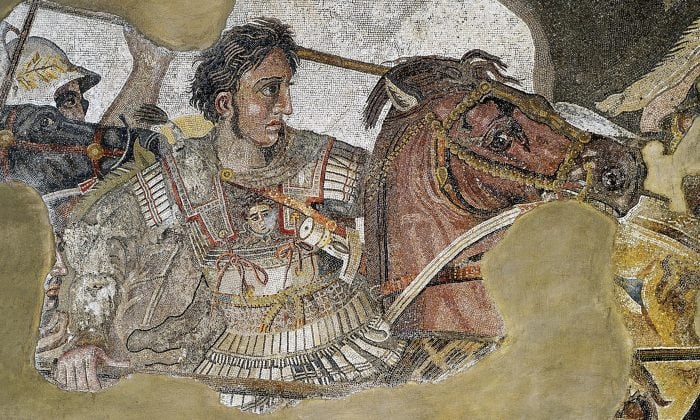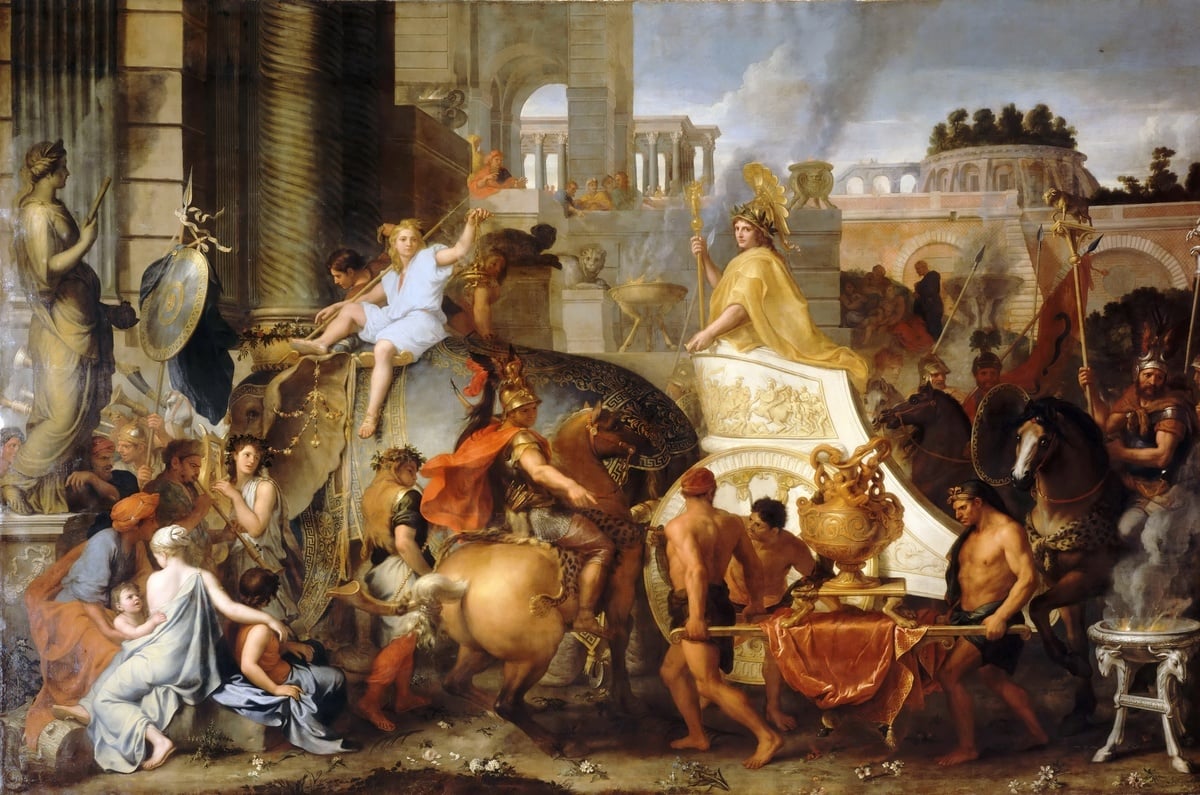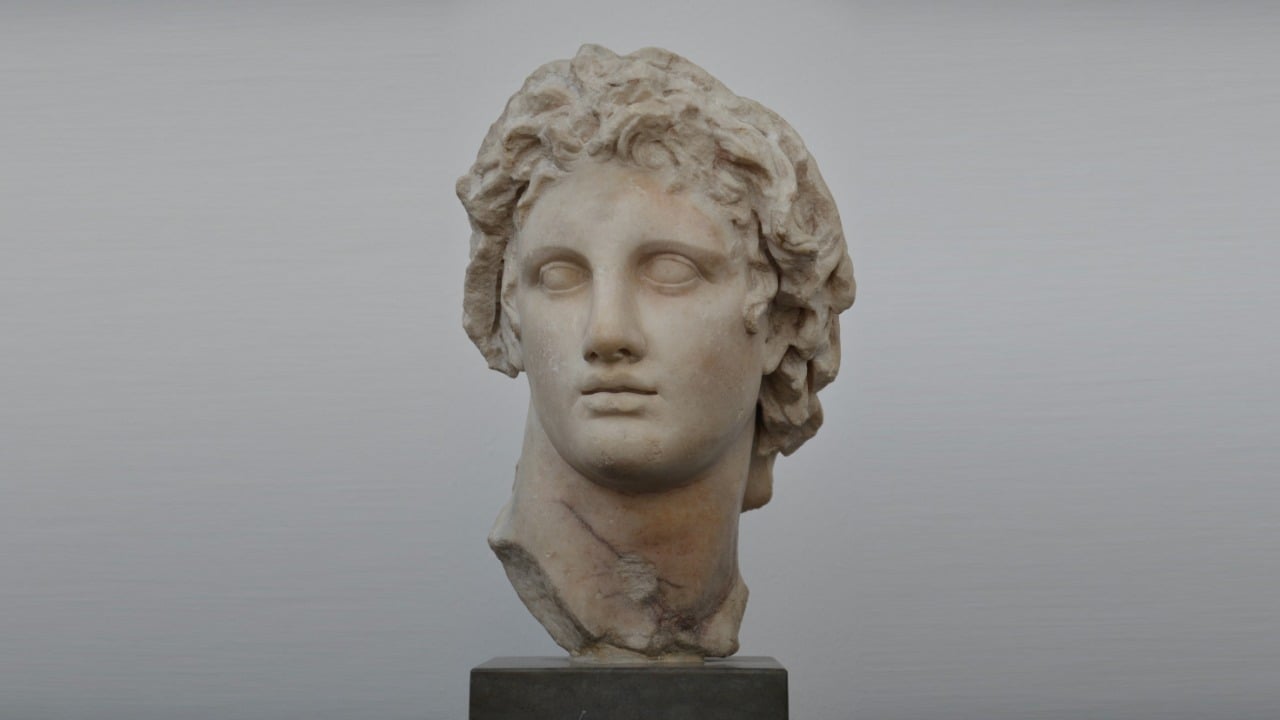
Archaeologists and scholars have spent nearly a century investigating what happened to Alexander the Great and where his tomb is located. Some argue that his tomb is in Macedonia, northern Greece, while others claim it is in Alexandria, Egypt, or even Babylon, but no one has been able to locate it. The tomb was most likely relocated more than once…
by Alexandre Schoedler-Tziamouranis
Historians say that Alexander the Great succumbed quite young to a mysterious disease. His tomb then fell into oblivion over the centuries to disappear from the memory of historians, leaving only a few passionate archaeologists and treasure hunters hoping to discover the remains of the only Greek who became a god during his lifetime.
Contradictory biographies
About 2,300 years after his reign and hundreds of biographies later, which cite mostly late Greek or Roman sources, one realizes after a comparative analysis that the picture that these writings draw of this man and king is very incomplete, contradictory, and even false for some statements and events.
History would have it that the ancient writings of the eyewitnesses of the life of Alexander have been lost. Yet, that belief is entirely false.
There is a more truthful historical vision of the life of Alexander the Great—namely, not only that of the king warrior, but also of the builder, reformer of laws, architect, philosopher, and head thinker of a revolutionary new idea which emerged. It was an innovative idea of a world united under a single law, a single global kingdom, and of universal peace for all by ending the era of seemingly unending wars.
This was an idea so dangerous that it pushed some of his ultra nationalist generals to foment three plots against him. The famous Greek hero managed to thwart them all, nevertheless, except for the third one which turned out to be fatal on June 13, 323 BC.
This deadly episode was hidden and then distorted by the historians of the court in charge of writing the history because they were themselves involved by personal motivation and greed.
Alexander did not die from disease Babylon tablets reveal
The question of what caused Alexander’s death is much disputed so still remains a topic of controversy and conflict. This is despite the fact that the archaeological discovery of the cuneiform tablets in Babylon, the last city where Alexander lived, confirm that he did not die from malaria or otherwise.
It was, in fact, only the speculation of historians, though all the events of the court and the city were meticulously registered and no incident of disease was recorded as having touched the city nor the Greek soldiers in 323 B.C., leaving the question of what caused his death open.
A modern hypothesis is that the great king died of pancreatic cancer, even though the symptoms do not match at all and the 14 day period of illness was way too short. Alexander also did not die of drunkenness. This too was a tale invented by the plotters and copied by historians for centuries. The truth, in fact, is that he was poisoned like his childhood friend Hephaestion on whom it had been tested on November 10th of 324 BC, a whole year earlier.
Then it was the turn of his Hindu brahman spiritual adviser, Kalanos. The wiseman returned with Alexander from his Indian campaign only to be eliminated through poison also by the generals supposedly because he had written a warning to one of the wives of the king that spoke of a plot in progress against Alexander.
There was, nevertheless, the writing quoted in the papyrus of Rhodes in 317 BC outlining who set the accusations of the conspiracy of the inner circle of generals against the war hero. The letter was later sent to Alexander’s mother, Queen Olympias, by a Cretan captain.

A case of embezzlement
Everything began with a case of embezzlement and corruption by the general Antipatros, who had received the order from the king to explain himself. He charged his two sons to ask Alexander for a delay, but they arrived at the king’s court with their own secret mission.
Their objective was to serve poisoned wine and food to rid themselves of Alexander. This was in alliance with Medios the Thessalian, the person in charge of the feasts and banquets of the king, and Apollodoros, the governor in charge, to keep the soldiers quiet after the murder.
The only person who would have been able to save him, a doctor who was an expert in poisoning incidents, was ingeniously kidnapped that very fatal night. He had already saved Alexander’s life once in India. He mysteriously disappeared that same late evening of the last banquet, ancient testimonies quote.
Soon enough, soldiers began to revolt as they learned of the conspiracy of the generals to overthrow the well-liked and well-hailed warrior.
The governor of the City of Babylon then entered into foul play in which he subdued the army’s unrest by force while the king was sick. Archaeological evidence, such as the cuneiform tablets and witness accounts, all attest to these dramatic events.
A coup d’état
The plot leading up to Alexander the Great’s death is what we call today a coup d’état that led to the cowardly murder of the king invincible in combat by his own generals at the height of his youth at nearly 33 years old.
A short time before, he had planned new projects such as a maritime campaign to Arabia and a trip to Europe to create commercial alliances. Once, he had conceived of departing merely with an expeditionary corps. This was because he had just completely reorganized the army, thus transforming it radically to end his large war campaigns.
It was recorded that once dead, his body did not decompose like others. All the history of Alexander the Great is thus to be rewritten in view of the new elements discovered. As well as in archaeology as in sight of the historical: the fragmentary texts of the direct occular witnesses of the entourage of Alexander! Bringing stunning accusations that explain what really happened on that ill fated night in Babylon! Such a case would bring the true story of Alexander’s death to the world.

Where is the tomb and the remains of Alexander the Great?
Alexander’s body mysteriously disappeared in Alexandria, Egypt for several millennia. As a an investigator, documentalist, and writer, I have therefore been searching for clues and tracks for more than twenty years and discovered that it had been moved no less than nine times.
That means that archaeologists have been looking in the wrong places because they were basing their search on the wrong locations. The correct chronology is as follows: the convoy with the remains of the king is kidnapped by the general and future Pharaoh Ptolemy I in Syria. It is then diverted from its return route to Macedonia for Egypt.
Ptolemy exposes the body of Alexander deified in public adoration for the population in July to August of 322 B.C. It will remain in the sarcophagus of Pharaoh Nectanebo II in Memphis until the year 280 BC, when the successor of Ptolemy, Ptolemy II, transferred the remains and the offerings to the temple of Isis in Alexandria. It was then moved to the summer palaces and ceremonial halls of Cap Lochias.
Decades later in 220 BC, Ptolemy IV built a mausoleum worthy of the king in the architectural style of the mausoleum of Halicarnassus, once beloved by Alexander. He constructed what would be the first ‘soma’ with a pyramidal completion at the top and placed the king’s catafalque there, adding a pure gold sarcophagus molded with the morphological aspects of the deified Alexander.
Access to the soma was strictly limited to members of the royal family and to priests dedicated specifically to the worship of the new god, Alexander.
In 185 BC, his successors embellished the tomb and deposited papyrus scrolls and statues. Then, in 89 BC, Ptolemy X began to plunder the tomb, removing Alexander’s golden sarcophagus and melting it to clean up the finances of the kingdom that is plagued with corruption. He had it replaced by a new translucent alabaster sarcophagus in order to look at the embalmed king through its milky looking glass.
In 51 BC until her death, Queen Cleopatra visited the grave daily to get inspiration for a new world kingdom with Rome and was often seen “talking” to him.
Generals, kings, and emperors also passed by Alexander’s bedside in the mausoleum: from Julius Caesar with Cleopatra to Mark Antony and Octavian, the future Augustus after the defeat of the queen.

Roman emperors rob Alexander’s tomb
In 38 AD, Caligula stole his cuirass. Then, it was the turn of the emperor Caracalla, who took his royal ring, tunic, and belt back to Rome in 214 AD.
In 269 AD, Queen Zenobia of Palmyra took the city of Alexandria in the raid for Egypt after fighting hard for it. The mausoleum was then walled up and hidden from the world to prevent damages caused by the war.
Then, it was the Roman emperor Aurelian’s turn to take back the city. In 273 AD, he therefore visited the tomb and took the spear of Alexander.
A great battle raged in 297 AD, when the emperor Diocletian crushed a usurper in Alexandria, and the Brouchion district near the royal palaces where the soma was located went up in flames. The tomb was walled up again and the body moved to a safe place by the priests of the cult of Alexander.
In July 365 AD, the forces of nature raided Alexandria when a gigantic tsunami ravaged just about the entire city. Ships in the port ended up on the top of buildings, the temples were partially destroyed, and fifty thousand dead bodies lay in the Alexandrian streets. The soma was completely flooded, but the body was saved.
The entire structure was moved afterwards, and remained in its new location until 391 AD. This time, it was the religious fanaticism of the Christian emperor of Rome, Theodosius, that provoked the closing of the tomb by accusing the cult of Alexander of contradicting the dogma. Alexander’s body was then taken out of the tomb and shown one last time in public as a sign of devotion.
The disappearance of Alexander the Great’s tomb
In 392 AD, priests in hoods took the body and other elements out of the tomb and hid them in an unknown place, causing them to disappear entirely from history. Around 450, the tomb disappeared for centuries from the world’s memory as well.
Arab writings that speak of it afterwards have, however, also been found. One of them is that of the traveler Hassan-Al-Wassan and his writings published in Venice in 1551 by the publisher Ramussio. Under his romanized name, Leonis Africanus, he spoke of having been able to visit a small chapel with a crypt of which only the pillars remained at a place near an antique doorway. There, he stated, one could ask the chapel’s guards to see the body of King Alexander.
Other explorers were also eyewitnesses of the new tomb of Alexander. In his description of Alexandria at the beginning of the 16th century, the Spanish explorer, geographer, trader and later historian Luis del Marmol de Carvajal, known as “Claude Marmol,” tells of having seen Alexander’s embalmed in his sarcophagus after having visited the nearby church of St. Mark.
The colonial geographer and English emissary George Sandys did the same, speaking of the same crypt in 1621. He specified having seen the sarcophagus and the mummified body of Alexander the Great and added that it had been moved again in the 10th century to the place where he had seen it.
Sandys also noted that, according to the guardians, in 954, Alexander was still visible to the faithful at the mosque Dûl-I-Qarnaïn-Nabi, as he was considered a prophet in the Quran (Surat XVIII, ‘Al Kahf ‘ the cavern) and that they await his return to this day.
A generation later, according to Imam Al Massoudi, his body and marble tomb were once again “removed” and taken to another mosque. They were then moved again to the place where George Sandys saw them in 1620 to 1621. In the 18th century, it was once more hidden by its guards to underground tunnels.
The rediscovery of Alexander the Great’s sarcophagus
In 1898, a French diplomat, lawyer, and spy by the name of Octave Borelli by chance came face to face with the tomb after a symposium of diplomats when he visited the basement of a consulate in Alexandria.
According to his testimony, the walls in the basements were heavily damaged by English bombing during the Egyptian’s anti-colonial insurrection in 1882. Of the many cracks in the walls, there was one where he was able to see a glint of gold sparkling in the light of a candle he was holding. The Frenchman was naturally astonished by what he saw. Desiring to see what was behind the old cracks, he dug an entrance together with another man.
What Borelli found behind the wall was another much older one. Once inside, he realized that he was looking at the body of Alexander the Great which he immediately recognized. Beside him lay his shield and other artifacts as well as offerings. He didn’t say a word to anyone, however, but instead returned with the help of a consul’s adviser several times to the tomb to make sketches, notes, and daguerreotypes.
Afterwards, Borelli returned to France, and a little later built a castle in the south with a suddenly acquired fortune. Wanting to have the body repatriated afterwards, he set up a rescue expedition with the help of Egyptians, Lebanese, and French noblemen and business expatriates.
In 1911, however, the Frenchman was murdered in Paris just one month before his next departure for Alexandria and the lost tomb. Unfortunately, he took his secrets with him, with the exception of a close friend to whom he had confided the secret.
Having met the descendant of that person, I was then able to reconstruct the full extent of his discovery as well as the objects he brought out of Egypt to build his fortune, which are now gathered in secret private collections in the U.S.A., England, and France. I know the names, the artifacts, and the places, however.
The quest
As the body of Alexander is still there, having not been moved to this time, so I contacted a renowned archaeologist in 2019 so that the quest might be picked up once again. After providing him with clues and testimony, the exact location of Alexander’s tomb could be determined in 2020 in less than a month.
Unfortunately, after 120 years, the consulate had also been destroyed, and it is now a residential building under private ownership, which makes it quite complicated to dig. Furthermore, because the company that owned the building refused any access to its sub-basement, it was impossible to carry out excavations there.
Access to the area to be explored was also walled up and closed with doors made out of multi-layer steel. The owner also issued threats against the archaeologist “TO NOT DARE ENTER THE ZONE!”
Nonetheless, all these elements as well as the archaeological evidence and historical sources have been collected into a history novel that was released in France in October 2022 under the title Alexander the Great, the assassination and the quest of the lost tomb.
In sight of national interest to Greece and the world, I am now looking for a Greek publisher so that the Hellenes can meet their historical heritage of Alexander the Great.
The legacy lives on…Alexandros Anesti!

About the author
Alexandre Schoedler-Tziamouranis is an award-winning writer and photographer specializing in ancient and modern history. He is also the author of successful historic novels as well as thrillers and fact-based, investigative books. He lives in the South of France and Greece. His article in Greek Reporter, written in November 2022, is an exclusive.
See all the latest news from Greece and the world at Greekreporter.com. Contact our newsroom to report an update or send your story, photos and videos. Follow GR on Google News and subscribe here to our daily email!



